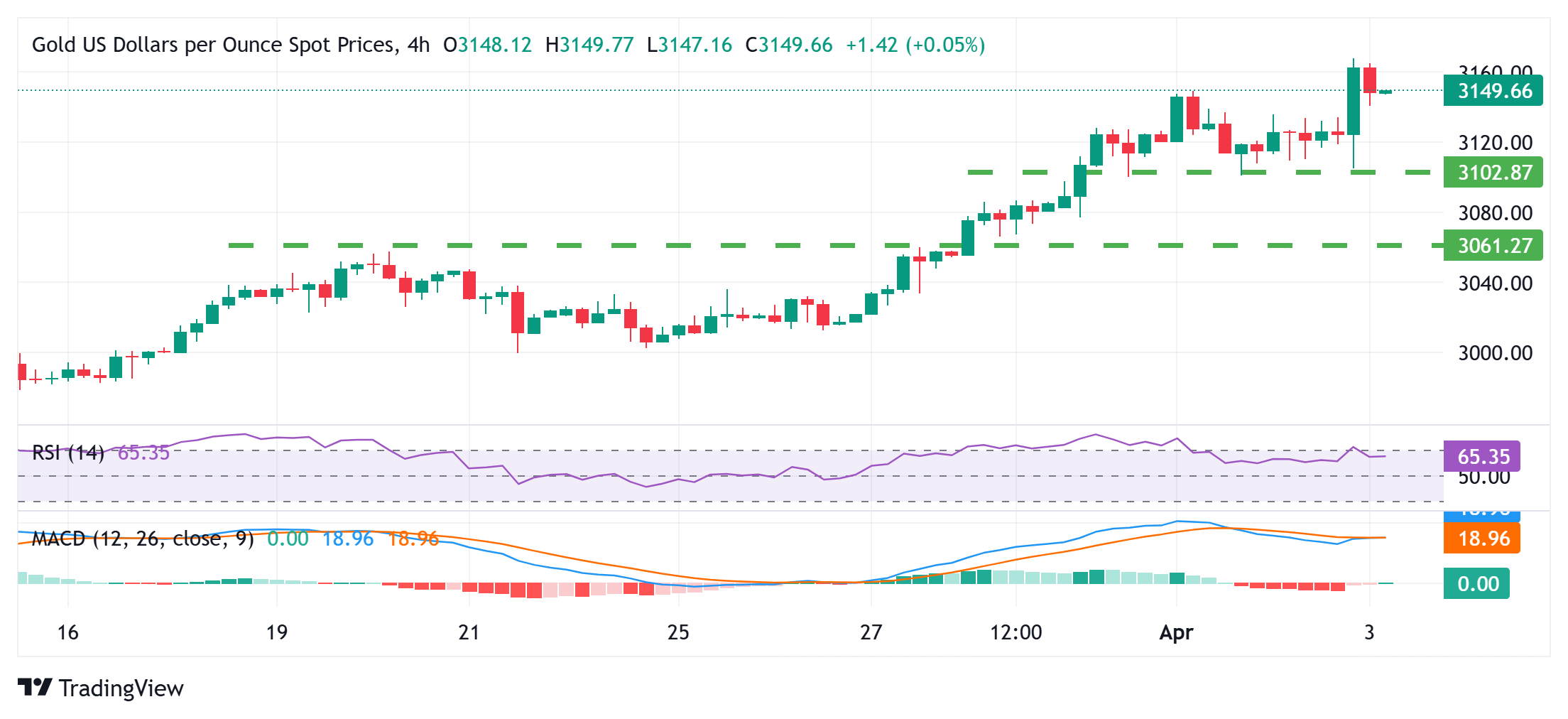Gold price buying remains unabated; fresh record highs being set amid risk-off mood
- Gold price rallies to an all-time peak amid heightened safe-haven demand on the back of Trump’s reciprocal tariffs.
- The USD hits a fresh YTD low amid slumping US bond yields and Fed rate cut bets, further supporting the precious metal.
- Bulls, however, pause for a breather and refrain from placing fresh bets amid bearish divergence on RSI.
Gold price (XAU/USD) shot to a fresh record high during the Asian session on Thursday as investors rushed to take refuge in traditional safe-haven assets amid the risk-off impulse. US President Donald Trump announced sweeping reciprocal tariffs on Wednesday evening, sparking concerns about global economic growth and a recession in the US. This, in turn, sparked a severe risk-off move, which is evident from a sea of red across the equity markets, and provided a strong boost to bullion.
Meanwhile, the anti-risk flow, along with the growing acceptance that a tariff-driven US economic slowdown, would force the Federal Reserve (Fed) to resume its rate-cutting cycle soon and trigger a steep decline in the US Treasury bond yields. This, in turn, dragged the US Dollar (USD) back closer to a multi-month low touched in March and further benefited the non-yielding Gold price. That said, extremely overbought conditions keep a lid on any further appreciating move for the XAU/USD pair.
Daily Digest Market Movers: Gold price prolongs the uptrend amid Trump’s tariffs-inspired global flight to safety
- US President Donald Trump imposed a 10% baseline tariff on all imports and higher duties on some of the country's biggest trading partners, sending shockwaves through global financial markets. In response, China’s Commerce Ministry stated that it will resolutely take countermeasures to safeguard its rights and interests.
- The developments raise the risk of a widening trade war, which could upset global free trade and impact negatively on the world economy. This, in turn, boosted demand for traditional safe-haven assets. Apart from this, the emergence of heavy US Dollar selling pushes the Gold price to a fresh record high on Thursday.
- Investors now seem worried that Trump's protectionist policies could potentially send the US economy into a recession and are pricing in a 70% chance that the Federal Reserve (Fed) will lower borrowing costs in June. Moreover, the anti-risk flow drags the US Treasury bond yields lower across the board, undermining the USD.
- On the economic data front, the US ADP reported on Wednesday that private-sector employers added 155K jobs in March – far more than the 105K expected and the previous month's revised reading of 84K. This, however, did little to impress the USD bulls amid concerns about the economic fallout from Trump's trade policies.
- Traders now look forward to the US economic docket – the release of the usual Weekly Jobless Claims and the US ISM Services PMI. Apart from this, trade-related headlines might influence the USD and provide some impetus to the XAU/USD pair ahead of the closely-watched US Nonfarm Payrolls (NFP) report on Friday.
Gold price needs to consolidate its recent gains before the next leg up amid bearish daily RSI

From a technical perspective, the Relative Strength Index (RSI) on the daily chart continues to flash overbought conditions and holds back the XAU/USD bulls from placing fresh bets. Hence, it will be prudent to wait for some near-term consolidation or a modest pullback before positioning for an extension of a multi-month-old strong uptrend. Nevertheless, the broader setup seems tilted firmly in favor of bullish traders and suggests that the path of least resistance for the Gold price remains to the upside.
Hence, any corrective slide below the Asian session low, around the $3,123 area, could be seen as a buying opportunity. This, in turn, should help limit the downside for the XAU/USD pair near the $3,100 mark, which should now act as a key pivotal point. A convincing break below, however, might prompt some long-unwinding and drag the Gold price to the $3,076 area, or the weekly swing low touched on Monday, en route to the $3,057-3,058 region, the $3,036-3,035 zone and the $3,000 psychological mark.
Tariffs FAQs
Tariffs are customs duties levied on certain merchandise imports or a category of products. Tariffs are designed to help local producers and manufacturers be more competitive in the market by providing a price advantage over similar goods that can be imported. Tariffs are widely used as tools of protectionism, along with trade barriers and import quotas.
Although tariffs and taxes both generate government revenue to fund public goods and services, they have several distinctions. Tariffs are prepaid at the port of entry, while taxes are paid at the time of purchase. Taxes are imposed on individual taxpayers and businesses, while tariffs are paid by importers.
There are two schools of thought among economists regarding the usage of tariffs. While some argue that tariffs are necessary to protect domestic industries and address trade imbalances, others see them as a harmful tool that could potentially drive prices higher over the long term and lead to a damaging trade war by encouraging tit-for-tat tariffs.
During the run-up to the presidential election in November 2024, Donald Trump made it clear that he intends to use tariffs to support the US economy and American producers. In 2024, Mexico, China and Canada accounted for 42% of total US imports. In this period, Mexico stood out as the top exporter with $466.6 billion, according to the US Census Bureau. Hence, Trump wants to focus on these three nations when imposing tariffs. He also plans to use the revenue generated through tariffs to lower personal income taxes.

